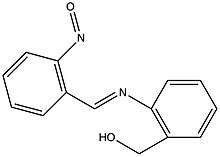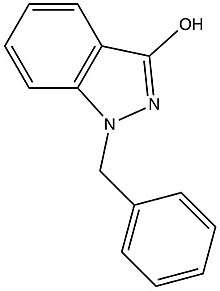Davis–Beirut reaction
The Davis–Beirut reaction is N,N-bond forming heterocyclization that creates numerous types of 2H-indazoles and indazolones in both acidic and basic conditions[1][2][3][4][5] The Davis–Beirut reaction is named after Mark Kurth and Makhluf Haddadin's respective universities; University of California, Davis and American University of Beirut, and is utilized for its lack of expensive materials and toxic metals.[3][6][7]
 Formation of 2H-indazoles by the Davis–Beirut reaction
Formation of 2H-indazoles by the Davis–Beirut reaction
Mechanism in base

The current proposed mechanism for the Davis–Beirut reaction in base was first published in 2005 by Kurth, Olmstead, and Haddadin. The reaction occurs when a N-substituted 2-nitrobenzylamine is heated in the presence of base, such as NaOH and KOH, and an alcohol and includes the formation of a carbanion [3] The reaction begins with the base removing a hydrogen (1) adjacent to the secondary amine-group, creating a carbanion. The carbanion then extracts an oxygen from the nitro-group (2), which is then subsequently protonated, most likely by water. The newly formed hydroxyl group (3), then extracts the secondary amines hydrogen, leaving a negative charge on nitrogen and creating a protonated hydroxyl group. The oxygen and its hydrogens then leave as a molecule of water (4), creating a double bond with the previously negatively charged nitrogen atom. The new pi bond makes the carbon adjacent to the nitrogen more susceptible for attack by a present alcohol (5), which in turn creates an oxygen-carbon bond, a bond between the two nitrogen atoms, and pushes electrons onto the oxygen molecule originally from the amide. This molecule is then protonated (6) to create an overall net neutral charge. The hydroxyl group is protonated similarly to step three (7), creating a good leaving group. Therefore, when the alpha hydrogen of the nitrogen atom and ether group (8) is extracted by the base, the flow of electrons creates two new carbon-nitrogen bonds and causes the loss of the protonated hydroxyl group as a molecule of water. The final product produced by this mechanism is therefore a 3-oxy-substituted 2H-indazole.
Slight variations of this mechanism exists depending on the starting materials and the conditions (acid or base) of the reaction.[2][1] In instances of intramolecular oxygen attack (i.e. step 5 of the proposed mechanism is intramolecular) an o-nitrobenzylidene imine intermediate is formed compared to the secondary imine of the displayed mechanism.[2]

Furthermore, Davis–Beirut reactions in acids form a carbocation as one of its transition states instead of the proposed carbanion one when the reaction occurs in base.[3]
Other variants of the Davis–Beirut reaction
By manipulating the starting materials of the Davis–Beirut reaction, researchers can create a large number of 2H-indazoles derivatives, many of which can be utilized for further synthesis.[1][6] In 2014, Thiazolo-, Thiazino-, and Thiazipino-2H-indazoles were synthesized utilizing o-nitrobenzaldhydes or o-nitrobenzyl bromides and S-trityl-protected primary aminothiol alkanes with a base, such as KOH, in alcohol.[1] Creating Thiazolo-, Thiazino-, and Thiazipino-2H-indazoles is beneficial since they are generally more stable than the oxo-2H-indazoles formed without the S-trityl-protected group, and they can easily be oxidized to sulfones.[1]

Creating 2H-indazoles via the Davis–Beirut reaction can also help in producing 1H-indazoles, naturally occurring and synthetically made molecules with known pharmaceutical uses such as anti-inflammatories and anti-cancer drugs.[6][8] By creating 2H-indazoles via the Davis–Beirut reaction, the product can subsequently be reacted with electrophiles, such as anhydrides, to create disubstituted 1H-indazoles that can be utilized for pharmaceutical and other industrial purposes.[6]
Applications
Heterocycles, especially those containing nitrogen atoms, are highly prevalent in many pharmaceutical drugs currently on the market.[4] Some, like those coming from 1H-indazoles, contain naturally occurring molecules, while others are purly synthetic.[8] 2H-indazoles, though, are very rare in nature compared to 1H-indazole compounds, most likely due to the complex nature of a heterocycle including a nitrogen-nitrogen bond and an ether side chain.[9] The discovery of the Davis–Beirut reaction therefore provides any easy and cost effective way to synthetically create 2H-indazoles.[4] Breakthroughs, including the success of introducing thioether moiety at C3 of the 2H-indazole structure, has aided in creating drug treatments for a variety of ailments, including cystic fibrosis, with the use of myeloperoxidase inhibitors.[4][6][10] Due to the recentness of the discovery of this reaction, though, most research is primarily headed by Haddadin, Kurth, or both, therefore causing a currently limited scope.[3]
References
- Farber, Kelli; Haddadin, Makhluf; Kurth, Mark (2014). "Davis-Beirut Reaction: Route to Thiazolo-, Thizaino-, and Thiazepino-2H-indazoles". The Journal of Organic Chemistry. 79: 6939–6945. doi:10.1021/jo501014e.
- Avila, Belem; El-Dakdouki, Mohammad; Nazer, Musa; Harrison, Jason; Haddadin, Makhluf; Kurth, Mark (November 28, 2012). "Acid and base catalyzed Davis-Beirut reaction: experimental and theoretical mechanistic studies and synthesis of novel 3-amino-2H-indazoles". Tetrahedron Letters. 53 (48): 6475–6478. doi:10.1016/j.tetlet.2012.09.026. PMC 3489190. PMID 23139435.
- Kurth, Mark J.; Olmstead, Marilyn M.; Haddadin, Makhluf J. (2005). "Claimed 2,1-Benzisoxazoles Are Indazalones". The Journal of Organic Chemistry. 70 (3): 1060–1062. doi:10.1021/jo048153i. ISSN 0022-3263. PMID 15675871.
- Mills, Aaron D.; Nazer, Musa Z.; Haddadin, Makhluf J.; Kurth, Mark J. (2006). "N,N-Bond-Forming Heterocyclization: Synthesis of 3-Alkoxy-2H-indazoles". The Journal of Organic Chemistry. 71 (7): 2687–2689. doi:10.1021/jo0524831. ISSN 0022-3263. PMID 16555821.
- Zhu, Jie S.; Haddadin, Makhluf J.; Kurth, Mark J. (22 July 2019). "Davis–Beirut Reaction: Diverse Chemistries of Highly Reactive Nitroso Intermediates in Heterocycle Synthesis". Accounts of Chemical Research. doi:10.1021/acs.accounts.9b00220.
- Conrad, Wayne E.; Fukazawa, Ryo; Haddadin, Makhluf J.; Kurth, Mark J. (2011). "The Davis–Beirut Reaction:N1,N2-Disubstituted-1H-Indazolones via 1,6-Electrophilic Addition to 3-Alkoxy-2H-Indazoles". Organic Letters. 13 (12): 3138–41. doi:10.1021/ol2010424. PMC 3112251. PMID 21612219.
- "'Davis-Beirut Reaction': Town recognizes gown, and vice versa". 30 Aug 2013.
- Bermudez, Jose; Fake, Charles S.; Joiner, Graham F.; Joiner, Karen A.; King, Frank D.; Miner, Wesley D.; Sanger, Gareth J. (July 1990). "5-Hydroxytryptamine (5-HT3) receptor antagonists. 1. Indazole and indolizine-3-carboxylic acid derivatives". Journal of Medicinal Chemistry. 33 (7): 1924–1929. doi:10.1021/jm00169a016. ISSN 0022-2623.
- El-Dakdouki, Mohammad H.; Hussein, AbdulSattar; Abdallah, Hiba; Shatila, Rania; Mouneimne, Youssef (September 2017). "Synthesis of novel 2 H -indazole analogues via the Davis-Beirut reaction and conjugation onto magnetic nanoparticles". Tetrahedron. 73 (39): 5769–5777. doi:10.1016/j.tet.2017.08.027. ISSN 0040-4020.
- "Prof. Haddadin on the Davis-Beirut Reaction". University of Balamand. November 19, 2017.